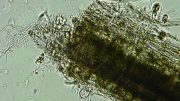
To a large extent, DNA methylation, which regulates vital cell functions, is still a mystery to the scientific world. Now, scientists have developed a method to quickly couple methylation enzymes to their respective methylation pattern. This finding could become essential for successful gene engineering in many species.
All species mark their DNA with methyl groups. This is done to regulate gene expression, distinguish indigenous DNA from foreign DNA, or mark old DNA strands during replication. Methylation is carried out by certain enzymes called methyltransferases, which decorate DNA with methyl groups in certain patterns to create an epigenetic layer on top of DNA.
Until now, scientists have not been struggling to tell which enzymes are responsible for which patterns. But in a new study, recently published in Nature Communications, scientists from The Novo Nordisk Foundation Center for Biosustainability (DTU Biosustain) at Technical University of Denmark have coupled enzymes with specific methylation patterns in two bacteria.
“Knowing which enzyme does what opens up to a lot of applications. With this knowledge, you can construct model organisms with artificial methylomes, mimicking the methylation pattern of the strain you want to introduce DNA to. In this way you can ensure ‘survival’ of introduced DNA,” says Specialist and first-author of this paper Torbjørn Ølshøj Jensen from DTU Biosustain.

Avoid getting DNA chopped
Scientists often run into problems with methylation, when they try to introduce foreign DNA to a host organism, for instance, bacteria or yeast. But introducing foreign DNA is essential when building production hosts – often called cell factories – capable of producing, for instance, medicine, sustainable bio-chemicals, and food ingredients. Often, the host needs genes (DNA) from other organisms in order to produce the sought-for compounds.
But just as often, the host will reject the foreign DNA and chop it into pieces, simply because the methylation patterns reveal that the DNA is alien. Scientists working with E. coli as their host, usually don’t have that many problems – or fewer than others – when introducing new DNA, since E. coli is well-known and rather “well-behaved.” But moving into lesser-known hosts can become a great problem.
“Working in other bacteria than E. coli, you often have to do a lot of trial and error when it comes to DNA transformation, but that’s just not good enough. You need knowledge and tools. With this, you have a systematic and rational way of fixing the problems,” Torbjørn Ølshøj Jensen says.

Coupling enzymes with activity
The goal was to find out, which enzymes are responsible for which patterns. In order to uncover this, the researchers constructed DNA rings (plasmids) containing one of the methyltransferases and “cassettes” holding multiple copies of certain DNA patterns. These DNA patterns, called motifs, are the targets for methyltransferases. By coupling the two, the methyltransferase expressed by the plasmid would mark the DNA in a specific way, thus, revealing the enzyme’s methylation pattern.
This was done for all methyltransferases. Afterward, all the plasmids (in a pool) were read using a sequencing method designed to reveal methyl groups. This gave the researchers a “library” of enzyme-to-motif couplings.
This quick method of identifying methyltransferase methylation patterns holds great promise for other researchers struggling with DNA degradation, according to the research team.

Assessing two industrial hosts
To validate the method, the scientists analyzed the genomes of the temperature-resistant bacterium M. thermoacetica as well as the bacterium A. woodii. Both bacteria are hosts with great potential for industrial applications and substantially modified genomes.
In total, the two bacterial organisms hold 23 methyltranstransferase genes, but only show modification on 12 different DNA motifs on their genomes, meaning that not all methyltransferases are active.
The team assessed all of the 23 methyltransferases, looking for those being active on the genomes. For 11 of the 12 motifs, they were able to couple activity to specific methyltransferases genes.
Using this method, the team hopes to design hosts with an unambiguous “methylome” – meaning that the organism only harbors wanted methyltransferases, which will ease the introduction of foreign DNA into non-model organisms. This can be useful both when building cell factories based upon new or lesser-known hosts, and in order to understand the regulation of gene expression and cell differentiation.
Reference: “Genome-wide systematic identification of methyltransferase recognition and modification patterns” by Torbjørn Ølshøj Jensen, Christian Tellgren-Roth, Stephanie Redl, Jérôme Maury, Simo Abdessamad Baallal Jacobsen, Lasse Ebdrup Pedersen and Alex Toftgaard Nielsen, 19 August 2019, Nature Communications.
DOI: 10.1038/s41467-019-11179-9
Abstract
Genome-wide analysis of DNA methylation patterns using single molecule real-time DNA sequencing has boosted the number of publicly available methylomes. However, there is a lack of tools coupling methylation patterns and the corresponding methyltransferase genes. Here we demonstrate a high-throughput method for coupling methyltransferases with their respective motifs, using automated cloning and analysing the methyltransferases in vectors carrying a strain-specific cassette containing all potential target sites. To validate the method, we analyse the genomes of the thermophile Moorella thermoacetica and the mesophile Acetobacterium woodii, two acetogenic bacteria having substantially modified genomes with 12 methylation motifs and a total of 23 methyltransferase genes. Using our method, we characterize the 23 methyltransferases, assign motifs to the respective enzymes and verify activity for 11 of the 12 motifs.









Extremely enjoyable articals Would have to do timely research to see this information THANK YOU
YEEY